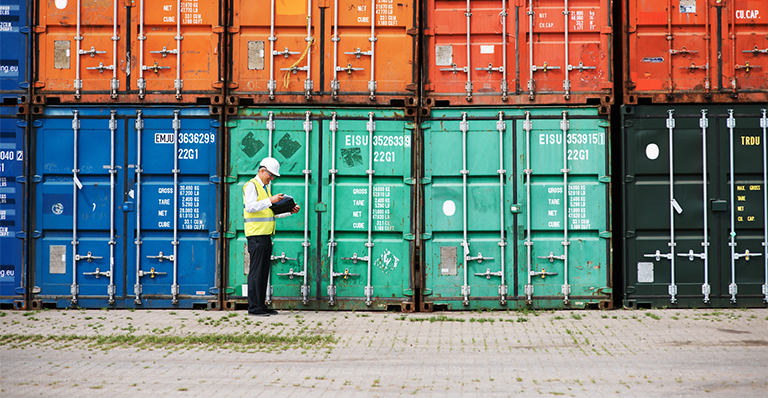Many Canadian businesses see the possibilities for growth and diversification in markets around the world. As more exporters become aware of the tremendous opportunities in the Indo-Pacific, they’ve begun exploring these markets more seriously. But the cost of shipping goods to distant customers can be a barrier to exporting, especially for small and medium-size enterprises (SME). Good freight management techniques can help reduce international shipping costs while getting products to your overseas customers in a timely manner.
Here are strategies and tips on how to minimize freight shipping costs, so you can diversify your export markets and start exporting to customers in more locations.
1.Understand your transportation options
How you ship is dictated by where you’re shipping your goods, the quantity and/or size of your shipment, and the goods themselves. From simple to complex, here are the primary transportation modes for exporters to consider.
- Road: Loading your products on a truck and sending them down the highway is the easiest, and often the cheapest, way to ship freight. This method works best for goods that are being delivered within the North American CUSMA (Canada-United States-Mexico Agreement) free trade zone and can move door-to-door without much handling.
- Rail: While less flexible than shipping by road, rail can be cost-effective and convenient. Railway containers are a “warehouse on wheels” that can hold your product before and after shipping. Rail schedules are reliable and predictable because the rail companies own the track. These features make rail shipping suitable for on-demand logistics and efficient supply chains. Trains also have a lower carbon footprint than ground and air transport.
- Air: Expensive compared to other shipping methods, air freight is used primarily to ship time-sensitive or high-value products, usually with smaller dimensions. This includes everything from live Canadian lobster to precision parts, or any other cargo with sufficient profit margin to justify the added shipping cost.
- Sea: International trade relies heavily on ocean freight. Inland waterways also provide important links in transportation infrastructure networks. Maritime shipping is often the most cost-effective and environmentally friendly way to move goods. Sometimes, it’s the only way to deliver goods long distances, or to reach certain destinations from Canada. But it’s slower than air freight, so it’s important to build longer lead times into your delivery plan.
- Intermodal: Most shipments require more than one form of transportation to reach their point of destination. Intermodal freight combines a variety of methods to move goods seamlessly through the different legs of their journey. It’s a cost-effective and efficient way to move cargo over long distances.
2. Work with an international freight forwarder
Working directly with a carrier is one way to move your goods. By managing the process yourself, you can save on fees and retain control of the products you’re shipping. But you must be prepared to manage all aspects of the shipping process, including warehousing, packaging, documentation, customs clearance, tracking and more.
In most cases, hiring a freight forwarder will be the more efficient and cost-effective choice. Freight forwarding companies manage the transportation and logistics aspects of international trade, coordinating with customs brokers and carriers to move your goods to their destination. They also provide a range of related services that can improve your supply chain performance and reduce freight-related headaches.
Freight forwarders can save you time and money by:
- leveraging their extensive networks to ensure the most efficient delivery path
- negotiating better deals on shipping rates than most SMEs can do on their own
- using their expertise in trade regulations and documentation to speed up market entry and avoid costly delays due to border issues.
“I like to say that freight forwarders are travel agents for cargo, because we arrange the entire process on behalf of clients,” says Arnon Melo, president of MELLOHAWK Logistics and a panelist on the EDC webinar, Mastering the logistics of export success.
With your freight shipping needs in the capable hands of your logistics partner, you can concentrate on your next contract and invest more time executing your business growth plan.
3. Consolidate your shipments
Shipping a full container is the most cost-effective way to move your goods. When you can’t fill it on your own, your freight forwarder can combine cargo from multiple orders to create a full container, reducing your cost. A freight forwarder can also combine orders for several of your customers into one shipment and get the products where they need to go when they reach their destination port. Even with the charges added by the freight forwarder for the service, consolidation can lead to significant savings.
Finding a freight forwarder
The Canadian International Freight Forwarders Association (CIFFA) is a great resource for exporters seeking a reliable logistics partner. Explore the CIFFA member directory to research CIFFA-approved freight forwarders by province, membership type and/or area of expertise.
EDC InList also simplifies your search for a freight forwarder. Our vetted list of service providers helps take the guesswork out of finding a logistics partner that meets your needs. Whether you lead a startup or an established business seeking growth in new markets, InList finds the right matches for you—local, national and international.
Sign up for a free MyEDC account to search EDC InList.
4. Reduce your carbon footprint
Embedding sustainability in your freight management strategy can save you money while reducing your carbon footprint.
“Ocean freight is generally the most affordable and the greenest transportation option, but it’s also the slowest. Especially when working with international buyers, it’s important to negotiate long lead times into your sales contracts so you can take advantage of it without risking a late shipment,” says Emiliano Introcaso, EDC advisor and senior product operations manager.
Before your cargo gets to port, a smart intermodal transportation strategy will enable you to use the most energy-efficient options for each leg of the journey, such as leveraging lower-carbon options like rail when possible. Investing in fuel-efficient and lower-emission vehicles for road transport can significantly cut both costs and carbon emissions. Partnering with green carriers who prioritize sustainability ensures that your freight operations align with eco-friendly goals, ultimately promoting a positive brand image and contributing to long-term savings.
Making sustainability a priority is also good for business. “Many companies look at shipping methods and materials when considering the sustainable elements of a contract,” says Introcaso. “So, having strong environmental policies in place can be a competitive accelerator.”
You should also check out
Learn trade compliance best practices, and how to connect with vetted supply chain partners
5. Familiarize yourself with Canada’s sea ports
While your freight forwarder will ensure that your cargo takes the most efficient route to its destination, being familiar with Canada’s sea ports and their capabilities can be helpful as you plan your international market expansion.
The Port of Montreal is the largest on Canada’s east coast for container traffic. The port ships a large volume cargo to the Indo-Pacific, which may surprise exporters who assume that freight bound for Asia must leave from the west coast.
“In the past decade, Asia has become the Port of Montreal’s growth engine” says Alain Berard, director of development and international relations for the Montreal Port Authority. “Our container volume to Asia has grown 371% since 2010.” Berard notes that the port’s global coverage, extensive intermodal connections to Canada’s major manufacturing hubs in southern Ontario, and strategic location on the St. Lawrence Seaway make it a convenient and green option for Central Canadian exporters.
“Since we’re 1,600 kilometers from the Atlantic Ocean, freight spends more time on a boat and less on land-based transportation, which typically means lower greenhouse gas emissions and lower carbon emissions,” says Berard.
As Canada’s largest port, the Port of Vancouver is a critical gateway for trade with Asia, Latin America, Europe and more. Handling over 140 million tons of cargo annually, it supports industries ranging from forestry to mining and agriculture. The port’s strategic location on the Pacific Ocean and its state-of-the-art facilities make it a linchpin in Canada’s trade network.
The Port of Halifax is the deepest container port on the East Coast of North America, making it capable of accommodating the largest cargo ships. It serves as a critical link for trade with Europe and beyond, facilitating the export of goods like seafood, forestry products and manufactured goods.
Canada’s secondary ports in Prince Rupert, British Columbia, St. John, New Brunswick, and Hamilton and Thunder Bay, Ontario, also play a crucial role in the national and global trade network. These ports provide valuable support to the supply chain, handling specialized cargo and providing regional markets with maritime freight access.
6. Don’t assume the lowest cost is the best option
Given the expense of international freight, it may be tempting to automatically select the lowest-cost mode or bid for your cargo. But the up-front savings won’t be worth much if you lose a customer to a late shipment. “It doesn’t matter how incredible your product is if it doesn’t get to your clients on time. That’s all they’ll remember. It will affect future business,” says Melo.
Besides investing in good supply chain management and freight management practices, you can deliver great customer service by managing expectations and ensuring clear communication before your goods go out the door. Be sure to negotiate reasonable delivery dates into your sales contract to avoid unnecessary expenses and screen your logistics partner carefully.
A reliable freight forwarder can significantly improve your relationships with customers and overseas partners by ensuring timely and safe deliveries. This not only guarantees quality assurance but also boosts your reputation as a dependable supplier. “Shipping and logistics isn’t simply about the final delivery to customers—it’s about all the deliveries that take place from start to finish in the process. One kink in the chain can have a devastating or cascading effect on the final delivery,” says Melo.
7. Protect yourself against export risk
To reduce costs to your business, it’s important to have the right insurance in place to protect both your cargo and your bottom line from common export risks.
Cargo insurance covers financial losses from theft, damage, or loss during transit. This is particularly important for high-value shipments or those involving multiple handling points, such as international shipments to the Indo-Pacific. Having cargo insurance also speeds up claims processing, enabling quicker recovery and replacement of lost or damaged items. By mitigating the risks associated with shipping, cargo insurance also helps stabilize your logistics budget, which makes financial planning and resource allocation easier.
Trade credit insurance is a vital safety net for exporters that protects you against the risk of non-payment by customers. EDC Credit Insurance covers your receivables, ensuring that you can recover up to 90% of the outstanding invoice if your customer defaults due to bankruptcy or non-payment, contract cancellation, issues with currency conversion or transfer, and more.
By mitigating the risk of not getting paid, credit insurance enhances your financial stability and cash flow, so you can extend competitive credit terms to international customers with confidence. Having trade credit insurance can also improve your access to working capital, as lenders are usually willing to lend against your insured receivables. Ultimately, credit insurance provides the financial security needed to explore new markets and expand your customer base internationally.
With a good freight management plan, smart partners, and the right financial solutions in place, your business can expand to markets around the world.
EDC’s Export Help Hub provides expert answers to the most frequently asked trade-related questions. Create a free MyEDC account for the answers to these questions related to shipping and freight forwarding, and ask an advisor a question of your own.
Q1 - I’m an e-commerce business. How can I develop a shipping strategy for my exports?
Q2 – What export costs do I need to consider? Is there a template or checklist I could follow?
Q3 - Where can I find cargo insurance to protect my international shipments?
Interested in growing your business globally?
Connect with EDC and watch your business flourish on the international stage.
Answer a few questions about your company to learn more about how EDC can help you plan, connect and fuel your global expansion.



